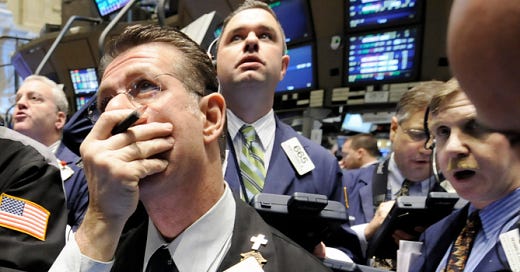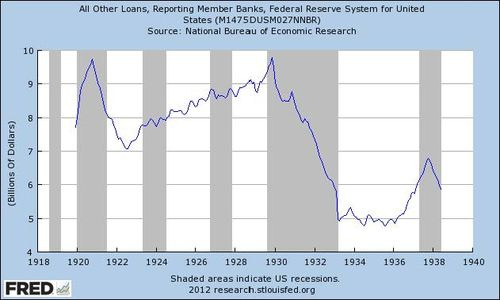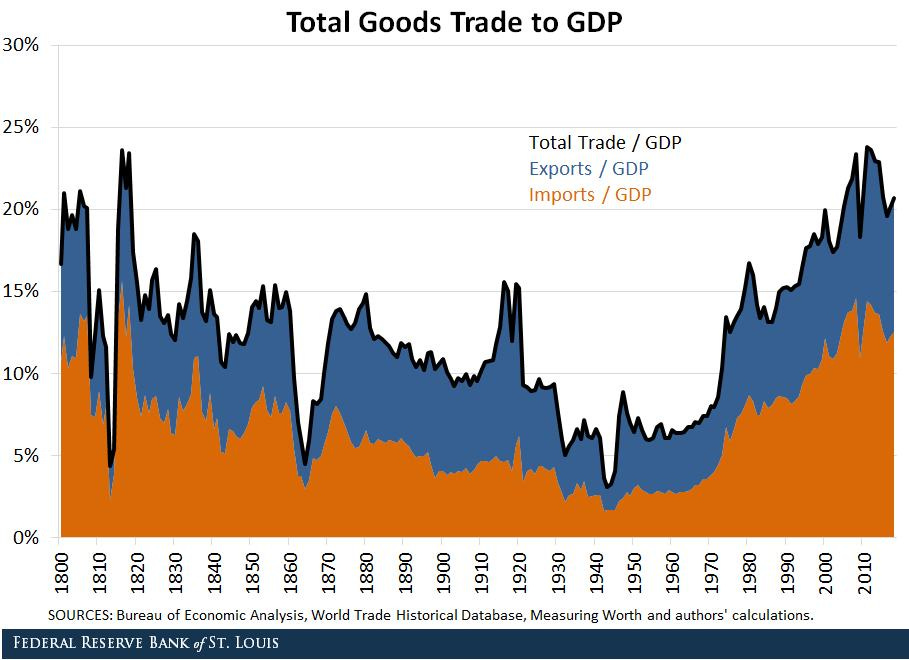Tariffs are good for nation states. We will take a look at the raising of tariffs after the Great Depression began and the removal of tariffs when the UK joined the EEC in 1973 to see how tariffs affect the economy.
(Business Insider)
The Great Depression began on Black Monday, October 28, 1929 when the price of shares on Wall Street declined by 13%. The decline in share prices continued until the Dow had lost all the gains it had made between 1925 and 1929.
The Great Depression was a typical boom/bust cycle, shares were rising rapidly and speculators took out bank loans to invest in shares. The smaller US banks became extremely exposed to this debt. When the inevitable crash occurred share values fell back to the pre-boom level and the gamblers lost their businesses and houses. The collateral for the bank loans disappeared and some banks became insolvent. There was then a run on the banks so that bank lending almost ceased. A banking crisis occurred.
The key cause of the Great Depression was a stock market boom. The boom itself was expedited by buying shares ‘on margin’ (where banks loan most of the money for share dealing and use the value of the shares as collateral).
The 1929-32 banking crisis resulted in a sudden withdrawal of money from the economy (just like in 2008). Businesses could not get loans or injections of shareholder funds and collapsed. US GDP fell by 26%.
So why do pundits say that the Great Depression was due to tariffs?
The Stock Market bubble of the late 1920s was always going to burst. However, imposing tariffs was a response to the bubble, not its cause. As in the 2008 banking crisis, it was the banks lending money without adequate collateral that caused the bubble. It was the Glass–Steagall legislation of 1932 that put the banks back on an even keel by separating investment from commercial banking. Glass-Steagall was steadily undermined after 1980 and effectively repealed in 1999, allowing a rerun of a full blown banking crisis in 2008.
In 1928 the whole of US international trade in goods was about 8% of US GDP. International Trade is a minor factor when compared with the halving of the money supply after the banks started to collapse. Tariffs did not cause the Great Depression, this idea is a deliberate lie put about by the Multinational Corporations and International Banks that depend on tariff-free trade.
Tariffs allow countries to maintain strategic industries and protect employment and a national skills base. China is about to confront the USA over Taiwan and the South China Sea. To be ready for this confrontation the US must ensure that its strategic industries such as silicon wafer production, micro-electronics, computing are safely away from Taiwan and South East Asia and that its heavy industry and manufacturing base is robust. The BRICS countries are openly working towards de-dollarisation and this threatens US trade and directly impacts the US economy. The USA must prepare for the eventual move of BRICS out of dollars, this, again, involves removing dependency on International trade. Tariffs are essential.
Fortunately the USA now realizes that the battle is beginning: Russian and Chinese National Socialism versus Freedom. Many in the USA actually care about good jobs and freedom. The EU and UK do not seem to mind the idea of National Socialism and care little for their own people.
To follow: Part2: The Effect of Joining the EEC on the UK Economy.
See The Globalist Threat and Tariffs and Economic Growth
The Detail
The Great Depression was caused by the collapse of US share values in 1929. The share values were highly inflated because of a speculative bubble fuelled by delinquent bank lending:
US Short Term interest rates rose during the speculative boom and fell rapidly afterwards:
Source: New World Economics
The money supply dried up. US Bank lending fell by almost 50%:
US GDP dropped by over 26%:
In 1929 there was clearly a stock market collapse followed by a banking collapse with a fall in the money supply as the banks regained a collateral base to back loans. As in the 2008 banking crisis, the loss of value of collateral in the form of property had the biggest effect:
(Source Real Estate Prices During the Roaring Twenties and the Great Depression, Wiley Real Estate Economics 2012)
The loss in collateral with the fall in property prices kept the money supply depressed.
Multinational corporations and international banks will try to sell you a completely faulty analysis of the Great Depression. The Depression was obviously caused by a speculative bubble and a banking crisis but they will try to tell us that it was because tariffs, the thing that affects them most, were too high.
The USA was not a great trading nation in 1929. US combined imports and exports were only about 8% of GDP in 1928. International trade may have been halved by the depression but that would have affected GDP by less than 4% because of domestic substitution of goods. International Trade fell by half after 1929 which would have been less than 10% of the fall in GDP that occurred. The other 90+% of the fall in GDP was due to the bank crisis. International trade was not the problem. It was too marginal to have been the problem.
(Source: St Louis Fed)
Exports fell dramatically in 1930 but this was due to the contemporaneous collapse of US industrial production. Imports, that were most affected by tariffs, scarcely fell at all. US International trade recovered by 1932 to the pre-1929 trend level then collapsed much further thanks to WWII.
Here is a graph of US Tariffs :
The blue line in the graph below is most important because 63% of all imports in 1933 were not dutiable:
Smoot-Hawley changed the average tariff rate on all goods from about 13% to 20%. Internationalist economists will ask you to believe that this was of crucial importance to the US Great Depression despite the stock exchange bubble collapsing, property prices crashing, the money supply halving and overseas trade only representing 8% of the US economy. Smoot-Hawley was a response to the Great Depression, not its cause. Correlation is not causation.
Tariffs are Necessary. Part 2
The Free Trade Mantra is that goods and services should be produced where they are cheapest. This will control prices and optimise production. There are several problems with this mantra. Thanks for reading There and Where Newsletter! Subscribe for free to receive new posts and support my work.











